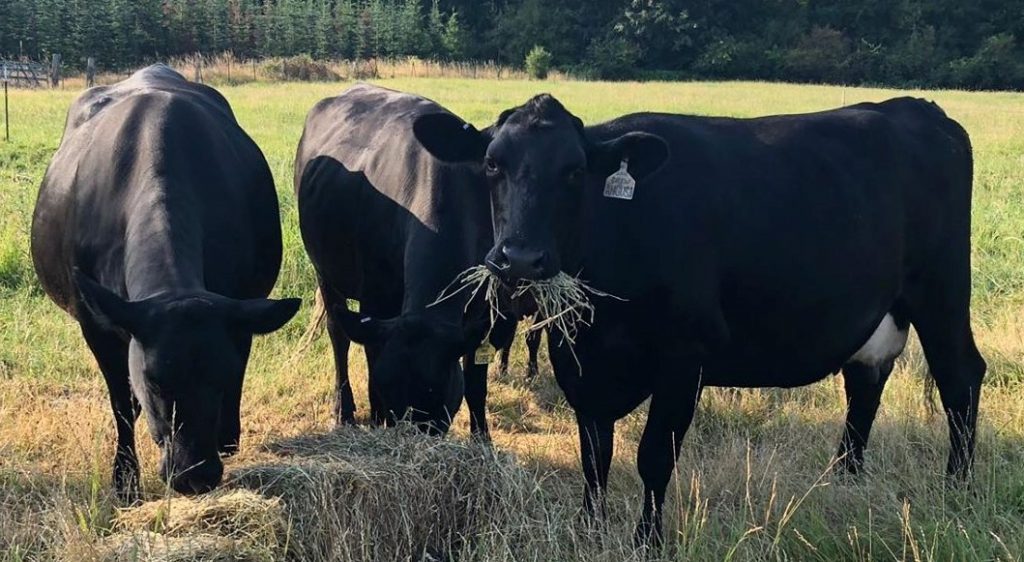Wagyu Beef
Wagyu beef cattle are originally from Japan and were used as draft animals, plowing the fields, until after the second World War, when they were also bred for meat. The word Wagyu literally means Wa =Japanese and gyu = Cow. A few of these animals were brought to the USA in the late 1980’s and early 1990’s to literally compete for the Japanese beef market. When Mad Cow scares took place in Canada in 2003, Japan used the opportunity to close this marketplace and the US farmers who had been selling Wagyu beef to Japan now had to find markets at home. This turned out to be a good thing for US farmers, because the US market is much bigger than the Japanese market, and Wagyu meat can now be found in many places in the USA.
The Wagyu breed has the unusual trait of putting more marbling into their muscle than other breeds of cattle. They also take longer to reach maturity, and instead of carrying a lot of saturated fat, the Wagyu are rich in the healthier unsaturated fats that give the beef a highly marbled appearance and its unrivaled flavor and tenderness.
Animals like deer, elk and cows first store their fat around their kidneys, then on their backs, and lastly in their muscles. The richer their forage, the faster they get to the point of storing fat in their muscles. The Wagyu start that process earlier than the typical beef animal. One will especially see this difference in animals that spend their last few months in feed, lots where they are fed the very rich diet of grain.

Our Wagyu
When we first started looking into the idea of raising beef animals, we thought we would raise Angus crosses, but the more we researched, the more interested we became in the Wagyu breed. They are smaller and more docile and take longer to reach slaughter weight. One may think this a bad trait, but we think this is good. We have been raising ours for two years before they are harvested. We have a closed herd of cattle (no new animals come to our farm), so we had to start with the animals we had. At that time, most of our dairy herd was purebred Holstein, so we bred (using AI Artificial Insemination) a few of them to Angus and to Wagyu. These turned out to be very good crosses because the Holstein cow gives a lot of milk, whereas the Wagyu cow does not. This means that our Wagyu calves get a lot of milk as young calves which is a very good thing. All of our mama cows are now either a Holstein/Angus/Wagyu cross, or a Holstein/Wagyu cross. We then bred them back to Wagyu and those calves are the animals we harvest. We and our customers have been very pleased with the results. We have therefor started breeding more of our Holstein to Wagyu in the hope of expanding the beef herd a bit.
Some of our first Wagyu calves had horns. This caused disruptive behavior in the herd. The animals with horns used them mercilessly on the ones who didn’t. We therefor decided to only get semen from Wagyu bulls that had the polled (no horns) genes and eliminated this problem. The animals are much kinder to each other now that no one has horns as an advantage. There is hierarchy of course, but no one has the advantage of horns to get higher on the pecking order.
We raise our Wagyu cattle on grass alone. They only get their mother’s milk, eat the grass in the fields and/or are fed hay and get salt and minerals as supplements. By being grass fed they do not have as much fat in their muscles as they would if they were fed grain, but we are great believers in grass fed and are sticking with that. We practice rotational grazing, so the cows are in constant movement around our farm. As one field gets eaten down, they get moved to another where feed is abundant. When the rains start in the fall, they move to the barn and are fed hay. There they have a large outdoor area and a so-called sacrificial field to hang out, but come into the barn to eat and to get out of the weather if they want.
These animals are particularly docile. There have been times we worried something was wrong, since they were just hanging around. But no, that seems to just be their nature. We were so used to our dairy cows who often are rather ornery to each other, that it took us some time to get used to the calm nature of these creatures. They are a delight to have around.
